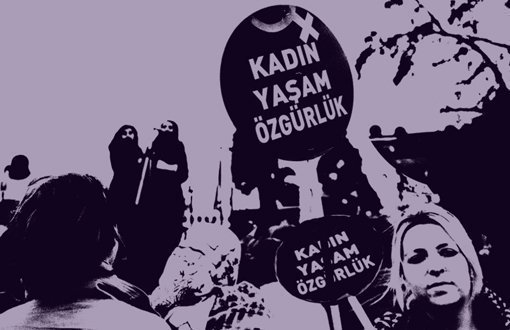Click to read the article in Turkish / Kurdish
According to reports bianet compiled from national and local newspapers, news websites and agencies, men killed 261 women and girls; raped 75 women; harassed 119 women; sexually abused 417 girls; injured 348 women in 2016.
CLICK - MEN KILLED OVER 284 WOMEN IN 2015
CLICK - MEN KILL 281 WOMEN IN 2014
CLICK - MEN KILL 214 WOMEN IN 2013
Murder
In addition to 261 femicides, bianet covered 66 additional killings of women: The perpetrators of the 31 femicides that occurred in 2016 have yet to be found; two of the victims were trans women. 14 women were found dead under suspicious circumstances. Three of them were trans women. 10% of these women came from Syria, with another 10% from countries like Georgia, Russia and Azerbaijan. 17 women and girls were subjected to violence, harassment, and/or rape committed or allegedly committed suicide as a result of the abuse. Three girls and one woman subjected to violence, harassment, and/or rape attempted suicide. ** Explanation: The bianet Male Violence Monitoring Report only covers women who lost their lives as a direct result of male violence. We do not take non-gender based crimes into account. Throughout the year, we keep track of unidentified murders and suspicious deaths of women in separate monthly tallies but do not add them to the number presented in the headline. We then esearch these cases to determine if the crimes were gender-based. If so, they are included in the end-of-year tally. In 2016, one unidentified murder was determined to be a gender-based crime. As a result, the number of femicides covered by the media in 2016 increased to 261. In total, 66 unidentified murders, suspicious deaths, suicides and attempted suicides remained unsolved or were not reported in the media.
|
17 women killed their attackers
Nine women killed the men who inflicted violence on them.
Eight women killed the harassers or rapists who attacked them. 75% of these were the women’s relatives, partners or ex-partners.
Men killed 261 women and 24 men in related crimes
24 men were killed in crimes related to the 261 murders of women in 2016.
Six of the murdered women were from Syria. Two of them were trans women.
One in four of the women killed in 2016 were attempting to end or rejecting the proposal to recommence a romantic relationship.
Excuses men cited for their violence include: women being unwilling to show phone messages or give phone passwords; quarrels about child care; being harassed by a stranger; resisting rape; as well as one woman receiving a text message from a man telling her husband he was “not fit to be a husband”.
6% of the women were killed despite protection orders. 9% of the women were killed despite demanding (and not receiving) protection orders against their husbands who were inflicting violence, or were killed right after a protection order had expired.
1.5% percent, or four of the murdered women, had been forced to marry at an early age.
4% of the women were killed by husbands who escaped (four) or left prison on permisson (six).
13.5% of the murders took place in public places, including streets, shopping malls, etc.
51% of the women were killed with firearms, 28% with knives and other sharp objects.
86 women were killed by guns, 47 by rifles, three by sharp objects and 71 by knives. 12 women had their throats slit, 17 were strangled, two were thrown from high places, eight were beaten, five by sharp objects, three tortured , three burned, and one was thrown out of a car and over a cliff; In three cases, the murderers' methods were not reported by the media.
68% of the women were killed by their partners (husband/boyfriends/fiance) or ex-partners, 10% were killed by relatives.
109 women were killed by their husbands of official marriage, three by their husbands of religious marriage, two by their fiances, 20 by boyfriends, 24 by husbands, 15 by ex-boyfriends, six spurned suitors, six by their fathers, 12 by brothers, one by her father-in-law, one by her brother-in-law, eight by male relatives, 10 by sons, 10 by son-in-laws, two by their daughters’ ex-husbands, two by partners of their daughter/mother/sibling, two by the ex-partners of their daughter/mother/sibling, two by men who entered their homes by identifiying themselves as officials, four by neighbors, three by male strangers, and 10 by other men who fall outside these categories. In eight femicides, the perpetrators’ relationship with the women was not reported in the media.
In 5% of the femicides, the killers were police officers, soldiers or private security staff, including six police officers, two retired police officers, two retired soldiers, one correction officer and two private security staff .
Trans murders and transphobic attacksOf the 261 women killed in 2016, two were trans women. At least 12 trans women were subjected to violence; at least one trans woman was raped and two trans women committed suicide. In addition, two more trans women were killed by unidentified perpetrators. Three trans women were found dead under suspicious circumstances. Yağmur Ada, was found dead in her home in İzmir province in July. It was later determined she lost her life due to a heart attack. |
Rape

At least 75 rapes of women appeared in the media in 2016.
8% of the women were not citizens of Turkey. 5% of them were disabled.
8% of the women were subjected to blackmail with nude or sexually explicit photographs.
8% of the rapists were previously convicted of sexual crimes.
43% of the rapists were arrested, while 25% were released.
24% of the rapists were strangers to the women they attacked, 11% were husbands/boyfriends of the women who broke up or sought to break up with them.
24 women were raped by male strangers, six by boyfriends they wanted to break up with, one by her ex-boyfriend, one by her husband she wanted to break up with, four by neighbors, seven by acquaintances, three by coworkers, three by men they met on social media, one by her boyfriend’s friend, one by her husband’s friend, one by her father’s friend, eight by male service providers (drivers, hotel worker, estate agent, hospital worker, waiter, security staff), one by a man who introduced himself as a psychiatrist at a hospital, one by an association director, three by teachers, one by a police officer, one by a [house employer, one by her employee. The identities of five perpetrators weren’t covered by the media.
40% of the rape incidents took place in homes men entered as guests, broke into or seized women.
12 women were raped in their homes, 12 in homes where where they were seized, six in homes their rapists had broken into, eight on the street, five in ruined houses or forested/deserted areas, and 19 in other locations, including including vehicles, hotels, hospitals, dorms, farms, stables, parking areas, entertainment venues, buses, elevators and tent cities.
Human trafficking and sex work by force
240 women were forced to perform sex work in 2016.
81% of the women forced to perform sex work were not citizens of Turkey. Their passports were seized and they were forced to work through various threats.
Only 22% of those who forced women to perform sex work were captured.
According to media reports, 183 perpetrators, both men and women, forced 240 women to perform sex work. 40 of these perpetrators were arrested, 23 were released on probation, and eight were discharged after giving testimony in court. 88 perpetrators were detained but their legal proceedings were not covered in the media. The media did not report any details about 24 of the perpetrators.
Harassment
Men harassed at least 119 women in 2016.
62% of the harrasers were male strangers, 10% were chiefs or bosses at their workplaces, 6% were the men they were paying for services (waiter, hospital staff, etc.).
74 women were harassed by male strangers, four by their husbands, one by her boyfriend, one by her ex-boyfriend, four by male relatives, four by neighbors, seven by men they were paying for services, one by a man who introduced himself as a doctor, 10 by male superiors at their workplaces, two by male coworkers, one by her family doctor, five by their teachers, four by acquaintences, and one by a male Ministry of National Education official.
39% of the harassment cases occured on the street, 10% on public transportation, 9% at workplaces, 4% at hospitals, 4% at places like shopping malls or markets.
47 women were harassed on the street, 12 on public transportation, 12 in their homes, five in the entranceways to their apartments, one in an elevator, five at hospitals, one in a clinic, 11 at their workplaces, five at places like shopping malls or markets, two in vehicles, one on a plane, two on beaches, three at schools, and one in a law office. The scenes of four harassment cases were not reported in the media.

70% of the women were subjected to physical harassment; 8% to exhibitionism, 6% to verbal harassment and 4% to digital harassment.
84 women were subjected to harassment physically, four by digitally, 10 by exhibitionism, one by being stalked, three by being photographed, two by threats. Four women were subjected to both physical and verbal, digital harassment and exhibitionism. Two women were subjected to being followed and verbal harassment. One man stuck a paper reading “shall we meet” with phone numbers on women’s backs. One man was caught masturbating in an operating room.
9% of the harassers were men who had been convicted of sexual crimes in the past. Only 23% of the harassers were captured in the cases that occurred in 2016.
In 2016 at least 98 men harassed 119 women. Of these 98 harassers, 23 were arrested. Seven of them were released on conditions of trial without arrest. Five men were released without any prosecution. 15 harassers were detained, however the following process wasn’t covered in the media. Legal process about the 49 harassers wasn’t covered at all in the media.
Child abuse
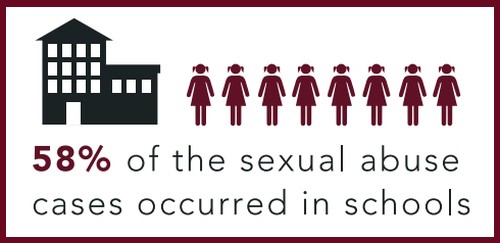
Men abused at least 417 girls in 2016.
58% of the sexual abuse cases occurred at schools. At least 13% of the girls were raped, at least seven girls got pregnant as a result of rape.
Sexual abuse cases that occurred at primary schools, secondary schools and high schools came to the fore in Turkey in 2016. The sexual abuse cases that started to be increasingly covered in the media in March hit the peak in March. The child abuse statistics, which started to drop after July following the end of school year, began to increase in October following the start of school year.
3% of the abused children were disabled.
At least 55 girls were raped, 14 subjected to digital harassment, 17 subjected to both digital and physical abuse. Most of the other cases took place in the media as only "sexual abuse".
53% of the girls were abused by teachers, 7% by school staff, 7% by relatives.
Principals and vice principals constituted 7%, religious schools teachers constituted 4%, course teachers constituted 39%, school founders and private education institute teachers constitute the rest of the abuser teachers.
221 children were abused by teachers (of the children 24 were abused by principals, eight by vice principals, 17 by religious school teachers, two by private education institution teachers, three by private education institution owners, two by high school founders, one by her sibling’s teacher, 164 by course teachers), 29 by school staff (four by cafeteria workers, 16 by workers at schools, five by shuttle drivers, two by electricians at schools, one by kindergarten staff), 13 by owners/workers of establishments near the schools (one by a grocer, four by owners/workers of buffets near the schools, eight by owners of the markets near the schools), 14 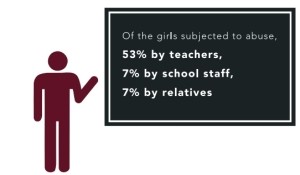 by other students, five by elder or younger brothers, two by fathers, six by step-fathers, 15 by male relatives, 12 by tradesmen in their neighborhoods, one by taxi driver, three by ex-boyfriends, one by a man whose proposal to commence a relationship was rejected, one by her mother’s employer, one by her father’s friend, one by her sibling’s friend, two by their mothers’ boyfriends, 11 by neighbors, five by men they met on social media, two by friends, one by an “exorcist”, one by her employer, one by neighborhood mukhtar, five by imams, six by a Ministry of Family employee, 43 by male strangers. Identities of 13 abusers was not reported in the media.
by other students, five by elder or younger brothers, two by fathers, six by step-fathers, 15 by male relatives, 12 by tradesmen in their neighborhoods, one by taxi driver, three by ex-boyfriends, one by a man whose proposal to commence a relationship was rejected, one by her mother’s employer, one by her father’s friend, one by her sibling’s friend, two by their mothers’ boyfriends, 11 by neighbors, five by men they met on social media, two by friends, one by an “exorcist”, one by her employer, one by neighborhood mukhtar, five by imams, six by a Ministry of Family employee, 43 by male strangers. Identities of 13 abusers was not reported in the media.
58% of the abuse cases against girls occurred at schools, 6% in children's homes, 5% in places where children were seized.
241 girls were abused at schools, 19 in locations where they were seized, 25 in homes, two in apparments, 10 on vehicles in which they were forcefully gotten, six in places like markets/grocery stores, six in ballet or Qoran courses, one in a mosque courtyard, one in a workplace, 20 on the streets, one in a camp, four on public transportation, one in a refugee camp, five in venues near schools, one in a school picnic, four in parks, one in a kindergarten, one in a gym, 10 on digital media. Locations of 55 abuse cases weren’t reported in the media.
155 men were arrested in 2016 due to sexual abuse cases against girls. While 41 men were released immediately following their testimonies, 20 others were released on conditions of trial without arrest. Only administrative investigations were launched into 13 abusers. Three teachers were just suspended, one religious school teacher was appointed to another school. One abuse by a vice principal was not even reported by the school management.
Violence - injury
Men inflicted violence on 348 women in 2016.
15% of the women were subjected to violence for attempting to divorce/break up or rejecting the proposals to commence/recommence a romantic relationship. Three women subjected to violence by men whom their daughers or friends attempted to divorce.
11% of the violence cases occured in public places including markets, public transportation or the streets.
7% of the women subjected to violence had protection orders or filed a complaint agains their attackers.
Two of the women subjected to violence had been forced to get married at an early age.
56% of the women were subjected to violence by partners, 11% by ex-partners or men whose proposal to commence a romantic relationship were rejected, 11% by male relatives.
115 women were subjected to violence by husbands of official and/or religious marriages, 35 by boyfriends, six by fiancees, 23 by ex-husbands, eight by ex-boyfriends, three by ex-fiancees, four by men they rejected their proposal to commence a romantic relationship, seven by daughters’ husbands, three by daughters’ ex-husbands, 11 by fathers, 13 by sons, six by elder or younger brothers, two by grandchildren, two by step-fathers, three by other male relatives, four by neighbors, four by friends, eight by the men they were paying for services (waiter, assistant driver, etc.), five by clients, two by thieves, one by a security staff, one by a doorman, one by a harasser, one by a man who bred ill will against her husband, one by the ex-husband of a woman who was working with her, one by her coworker, one by her employer, one by her friend’s boyfriend, one by her student, 25 by male strangers. Identity of the attackers in 10 cases weren’t reported in the media.
21% of the women were injured with knives(sharp objects, 18% with firearms, 50% by being beaten.
173 women were beaten, 68 were injured with knives, four with sharp objects, 28 with rifles, 34 with guns, five burned, four tortured, two thrown from higher place. Six women’s homes/cars were burned, shot or detonated. Vehicles were driven onto five women or they were thrown over a cliff. Four women were taken hostage. Four women were threatened with guns. One woman’s child was kidnapped.
Femicides predominantly occurred in İstanbul, İzmir, Antep, and Antalya
According to reports in the media in 2016, the most femicides occurred in İstanbul, İzmir, Antep, and Antalyaprovinces. 30% of the femicides covered by the media occurred in this four cities.
At least 26 women were killed in İstanbul, 21 in İzmir, 16 in Antep and 16 in Antalya.
2016 boyunca medyaya yansıyan kadın cinayetlerinin şehirlere dağılımı şöyle:
Distribution of the femicides that were reported in the media during 2016 by cities is as follows:
İstanbul (26), Kocaeli (10), Bursa (8), Balıkesir (5), Yalova (3), Tekirdağ (2), Edirne (2), Kırklareli (1), Sakarya (1), Ankara (11), Konya (9), Kayseri (6), Eskişehir (5), Aksaray (3), Karaman (3), Çankırı (1), Kırıkkale (1), Kırşehir (1), Sivas (1), İzmir (21), Muğla (6), Manisa (5), Denizli (3), Aydın (2), Kütahya (1), Uşak (1), Afyon (1), Antalya (16), Adana (11), Mersin (8), Osmaniye (2), Isparta (2), Maraş (2), Burdur (1), Trabzon (5), Çorum (4), Zonguldak (3), Düzce (3), Bolu (2), Ordu (2), Tokat (1), Amasya (1), Samsun (1), Karabük (1), Bartın (1), Kastamonu (1), Bayburt (1), Giresun (1), Elazığ (5), Van (4), Iğdır (3), Malatya (2), Bitlis (1), Erzincan (1), Erzurum (1), Antep (16), Urfa (5), Batman (3), Diyarbakır (3), Mardin (2).
* bianet will cover only femicide cases’ distribution by cities since 2016 in the annual male violence monitoring report. Sexual and physical violence cases constitute only peak of the iceberg. Millions of women are subjected to harassment, various sexual and physical violence forms in Turkey everyday. We know that many married women are subjected to domestic rape everyday. However, these violence cases, which are inured in society and turned into an element of “embarassment” for women, are mostly not recorded. When women inform law enforcers of what they go through or take legal steps, they are subjected to trauma over and over. Rapists, harassers, men inflicting violence lodge libel suits against the women who file a complaint against them. Even though all femicides are not reported in the media, femicides are newsworthy for particularly local newspapers, so most of the femicides are covered by the media. We can report the cases, which managed to “qualify as news” in the bianet tally. |
(ÇT/TK)






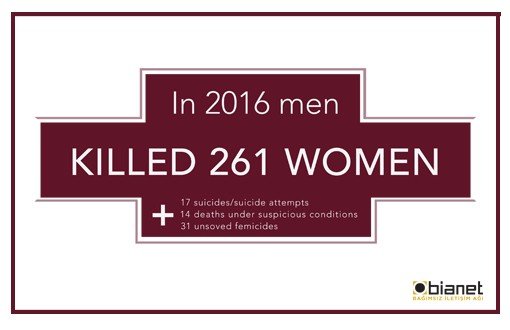

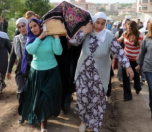
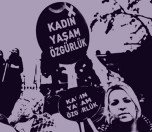
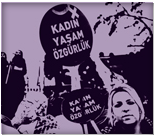

.jpg)



